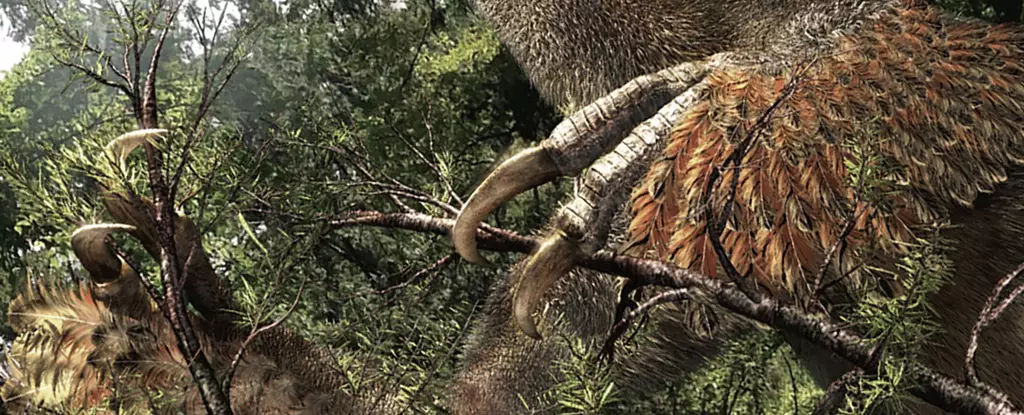A recent fossil discovery in southeastern Mongolia has thrown open the doors of paleontology to surprising new interpretations of dinosaur evolution. Dubbed Duonychus tsogtbaatari—Greek for ‘two claws’—this feathered, bipedal dinosaur challenges centuries of understanding regarding therizinosaurs, a clade typically characterized by their three-fingered hands. Unearthed from the Bayanshiree Formation, an area rich in Cretaceous-era fossils due to its unique sedimentary layers, this specimen offers a vivid glimpse into the past, with its finely preserved features including exceptionally large, claw-like talons that provoke both intrigue and astonishment.
Researchers from the Mongolian Academy of Sciences meticulously excavated the fossil in 2012, revealing more than just a new species; they unearthed clues that might rewrite how we perceive dinosaur adaptability and ecological strategies. For the first time in the history of therizinosaurs, scientists have recorded a species with only two functional fingers—an attribute that raises questions about evolutionary advantages and biological imperatives.
The Remarkable Morphology of Duonychus
What truly sets Duonychus apart is its anatomy, particularly its unique grasping mechanism, enabled by those imposing two-fingered claws, which measure nearly 12 inches. The fossil shows the keratin sheath still intact, hinting at what these claws might have looked like, and indicates their possible functions beyond mere predation. Unlike the common three-fingered structure seen in its relatives, the reduced digits force us to consider the ramifications of losing a finger for a creature that likely relied on dexterity for feeding.
This anatomical deviation signals a shift in evolutionary strategies, possibly indicating a move towards a herbivorous or omnivorous diet. The researchers speculate that Duonychus might have developed its peculiar talons to efficiently grasp and strip foliage, akin to contemporary sloths and chameleons. Such behavioral complexities illustrate that evolution is not merely a linear progression, but rather a mosaic of adaptations responding to environmental demands.
Evolutionary Puzzles and Ecological Roles
The emergence of Duonychus raises important questions about evolutionary trajectories within theropods. While reduced digit counts are unusual, they are not altogether absent within the Theropoda clade. The notion that Duonychus settled on a two-fingered anatomy rather than the standard three might suggest an evolutionary experiment tailored to its ecological niche. This insight contradicts a long-held belief that specific anatomical features dictate survival in particular habitats.
In their research, the authors discuss the multifaceted roles claws play in animal behavior—extending beyond hunting to territorial displays, courtship rituals, and social interactions. The claws of Duonychus, initially perceived as tools for foraging, may also signal commitment to evolutionary success across various other dimensions of its life. The evolutionary narrative of this dinosaur is complicated; it ends up being a compelling mix of utility, adaptation, and behavior rather than a straightforward tale of survival of the fittest.
The Significance of the Find
The discovery of Duonychus tsogtbaatari is more than just an academic curiosity; it serves as a critical reminder of the potential surprises lurking within our planet’s geological layers. As paleontologists painstakingly decode the past, they unveil adaptations that stretch and shift our comprehension of what it meant to be a dinosaur. This fossil raises the stakes—for both researchers and enthusiasts alike—by highlighting that biological diversity was not solely a matter of survival, but also of experimentation and innovation.
In an era increasingly concerned with biodiversity loss, the resurgence of interest in species like Duonychus showcases nature’s inexhaustible creativity. It forces us to reflect on our current understanding of evolutionary processes and challenges the preconceived notions that often dominate scientific discourse. The implications of this two-fingered dinosaur extend beyond paleontology; they touch on broader discussions about adaptation, ecological niches, and the inherent unpredictability of life itself.
In sum, the unearthing of Duonychus tsogtbaatari illuminates a fascinating corner of our prehistoric past, serving as both a scientific breakthrough and a philosophical touchstone for how we understand evolution’s complexities. In a world where strange can often mean the improbable, Duonychus reminds us of the infinite possibilities etched into the annals of time.



Leave a Reply